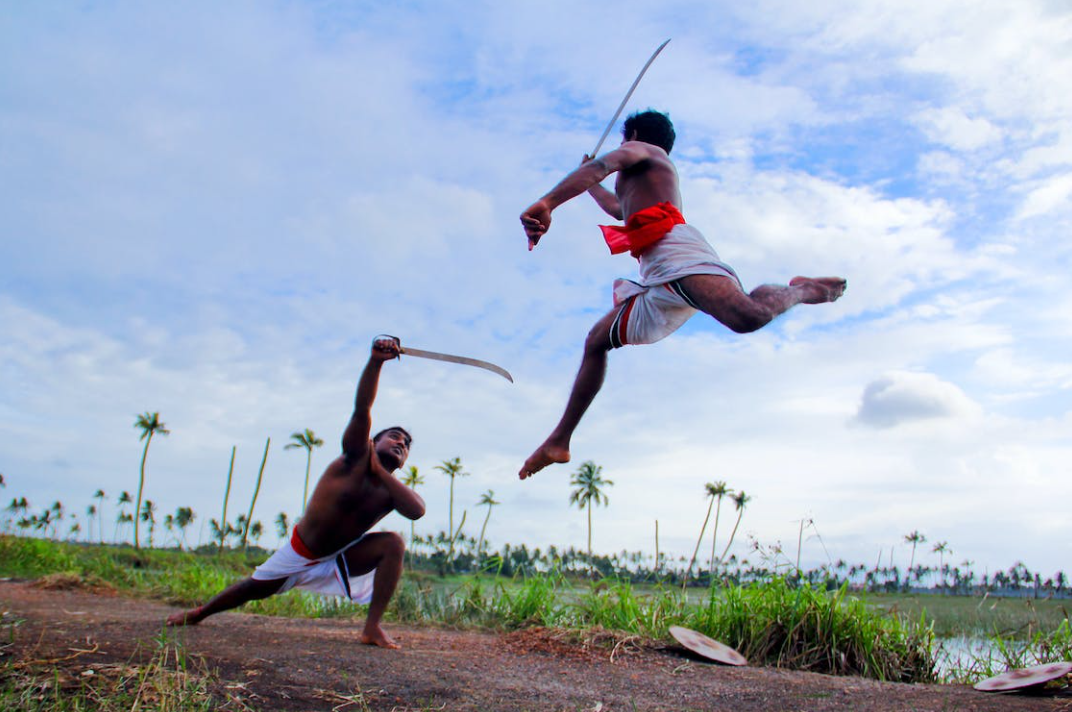
Kalaripayattu is a traditional Indian martial art that has a history spanning thousands of years. Its origins are shrouded in mystery and legend, but it is believed to have been developed in the state of Kerala in southern India.
According to legend, Kalaripayattu was developed by Parasurama, an incarnation of the Hindu god Vishnu. Parasurama was said to have created the martial art as a means of defending himself and his people from the Brahmins, a priestly caste that ruled over Kerala at the time.
While the exact origins of Kalaripayattu are unclear, there is evidence to suggest that it has been practiced in Kerala for over 2,000 years. The earliest written records of the martial art date back to the 3rd century BCE, when it was mentioned in the Tamil Sangam literature.
Kalaripayattu was initially developed as a form of combat training for warriors and soldiers, and was used extensively in ancient warfare. Over time, it evolved into a more comprehensive system that included physical and mental training, as well as spiritual and philosophical teachings.
One of the key features of Kalaripayattu is its emphasis on flexibility and agility. Practitioners of the martial art are trained to move fluidly and gracefully, using a combination of kicks, strikes, and throws to defeat their opponents.
Another important aspect of Kalaripayattu is its focus on weapons training. Practitioners of the martial art are trained to use a wide range of weapons, including swords, spears, bows and arrows, and even traditional Indian weapons such as the urumi, a flexible sword made from steel.
Despite its ancient origins, Kalaripayattu remained relatively unknown outside of India until the mid-20th century. It was only after India gained independence in 1947 that efforts were made to promote the martial art on a wider scale.
One of the key figures in the modern history of Kalaripayattu is Guru C. V. Govindankutty Nair, a renowned master of the martial art who founded the CVN Kalari Sangham in the 1950s. Nair was instrumental in promoting Kalaripayattu both in India and abroad, and his efforts helped to raise awareness of the martial art among martial arts enthusiasts around the world.
Today, Kalaripayattu is recognized as one of the world’s oldest and most effective martial arts, and is practiced by thousands of people around the world. It has also influenced other martial arts, including karate, kung fu, and capoeira.
In addition to its practical applications, Kalaripayattu is also valued for its spiritual and philosophical teachings. The martial art emphasizes the importance of discipline, self-control, and inner strength, and teaches practitioners to cultivate a sense of harmony and balance in their lives.
Kalaripayattu is also closely associated with traditional Indian medicine, or Ayurveda. Practitioners of the martial art are trained in the use of medicinal plants and herbs, as well as massage and other therapeutic techniques, and are often sought out for their expertise in these areas.
Despite its many strengths, Kalaripayattu faces several challenges in the modern world. One of the biggest challenges is the lack of standardization and regulation in the practice of the martial art. Unlike many other martial arts, Kalaripayattu does not have a centralized governing body or standard curriculum, which can make it difficult for practitioners to receive proper training and certification.
Another challenge facing Kalaripayattu is the rise of modern martial arts such as MMA and Brazilian Jiu Jitsu. While Kalaripayattu remains a popular martial art in India and other parts of Asia, it has struggled to gain a foothold in the Western world, where modern martial arts have gained widespread popularity in recent years.
However, despite these challenges, Kalaripayattu remains a vibrant and dynamic martial art with a rich history and culture. In recent years, there has been a growing interest in the martial art, both in India and around the world, and efforts are being made to promote and preserve the traditions of Kalaripayattu for future generations.
One way in which Kalaripayattu is being preserved is through the establishment of kalari schools and training centers. These centers provide structured training and certification programs, and help to ensure that practitioners receive proper instruction and guidance in the practice of the martial art.
Another way in which Kalaripayattu is being preserved is through the efforts of cultural organizations and government agencies. In recent years, there has been a growing recognition of the cultural and historical significance of Kalaripayattu, and efforts are being made to preserve and promote the martial art as part of India’s rich cultural heritage.
Overall, the history of Kalaripayattu is a rich and fascinating one that spans thousands of years. From its origins as a form of combat training for warriors and soldiers, to its development as a comprehensive system of physical, mental, and spiritual training, Kalaripayattu has played an important role in the history and culture of India.
Today, Kalaripayattu continues to thrive as a vibrant and dynamic martial art with a growing following around the world. As efforts are made to preserve and promote the traditions of Kalaripayattu, it is likely that the martial art will continue to play an important role in the cultural and sporting life of India and beyond for many years to come.